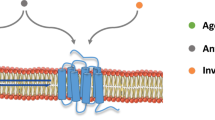Summary
The effects of different membrane preparations and assay conditions on [3H]5-HT binding to post-mortem human cortical tissue was studied. Optimal binding necessitated thorough removal of endogenous 5-HT and this was achieved either by hypotonic lysis or by preincubation of the membranes at 37‡C. Calcium chloride (4 mM) increased specific [3H]5-HT binding. The further addition of ascorbic acid (5.7 mM) or ascorbic acid and clorgyline (10 ΜM) reduced specific [3H]5-HT binding.
Similar content being viewed by others
References
Bennett JP, Snyder SH (1976) Serotonin and lysergic acid diethylamide binding in rat brain membranes: relationship to postsynaptic serotonin receptors. Mol Pharmacol 12: 373–389
Bradley PB, Engel G, Feniuk W, Fozard JR, Humphrey PPA, Middlemiss DN, Mylecharane EJ, Richardson BP, Saxena PR (1986) Proposals for the classification and nomenclature of functional receptors for 5-hydroxytryptamine. Neuropharmacology 25: 563–576
Cheetham SC, Crompton MR, Katona CLE, Horton RW (1988) Brain 5-HT2 receptor binding sites in depressed suicide victims. Brain Res 443: 272–280
Christophersen BO (1968) The inhibitory effect of reduced glutathione on the lipid peroxidation of the microsomal fraction and mitochondria. Biochem J 106: 515–522
Fowler CJ, Oreland L, Callingham BA (1981) The acetylenic monoamine oxidase inhibitors clorgyline, deprenyl, pargyline and J-508: their properties and applications. J Pharm Pharmacol 33: 341–347
Fowler CJ, Tipton KF (1982) Deamination of 5-hydroxytryptamine by both forms of monoamine oxidase in the rat brain. J Neurochem 38: 733–736
Heuring RE, Peroutka SJ (1987) Characterization of a novel3H-5-hydroxytryptamine binding site subtype in bovine brain membranes. J Neurosci 7: 894–903
Leslie FM, Dunlap III CE, Cox BM (1980) Ascorbate decreases ligand binding to neurotransmitter receptors. J Neurochem 34: 219–221
Lowry OH, Rosebrough NJ, Farr AL, Randall RJ (1951) Protein measurement with the Folin phenol reagent. J Biol Chem 193: 265–275
Marcusson J, Oreland L, Winblad B (1983) Serotonin binding in mouse brains. Some methodological aspects. J Neural Transm 56: 251–263
Muakkassah-Kelly SF, Andresen JW, Shih JC, Hochstein P (1982) Decreased [3H]serotonin and [3H]spiperone binding consequent to lipid peroxidation in rat cortical membranes. Biochem Biophys Res Commun 104: 1003–1010
Muakkassah-Kelly SF, Andresen JW, Shih JC, Hochstein P (1983) Dual effects of ascorbate on serotonin and spiperone binding in rat cortical membranes. J Neurochem 41: 1429–1439
Nelson DL, Herbet A, Bourgoin S, Glowinski J, Hamon M (1978) Characteristics of central 5-HT receptors and their adaptive changes following intracerebral 5,7-dihydroxytryptamine administration in the rat. Mol Pharmacol 14: 983–995
Pedigo NW, Yamamura HI, Nelson DL (1981) Discrimination of multiple [3H]5-hydroxytryptamine binding sites by the neuroleptic spiperone in rat brain. J Neurochem 36: 220–226
Pycock CJ, Horton RW (1978) Regional changes in the concentration of cerebral monoamines and their metabolites after ethanolamine O-sulphate induced elevation of brain γ-aminobutyric acid concentrations. Biochem Pharmacol 27: 1827–1830
Weiner N, Arold N, Wesemann W (1982) Possible hazards in serotonin binding assays in human and rat brain: effects of ascorbate, pargyline, and buffer concentration. J Neurosci Methods 5: 41–45
Wills ED (1969) Lipid peroxide formation in microsomes. Biochem J 113: 315–324
Author information
Authors and Affiliations
Rights and permissions
About this article
Cite this article
Cheetham, S.C., Horton, R.W. [3H]5-HT binding in post-mortem human cerebral cortex: methodological considerations. J. Neural Transmission 78, 53–59 (1989). https://doi.org/10.1007/BF01247113
Received:
Accepted:
Issue Date:
DOI: https://doi.org/10.1007/BF01247113




